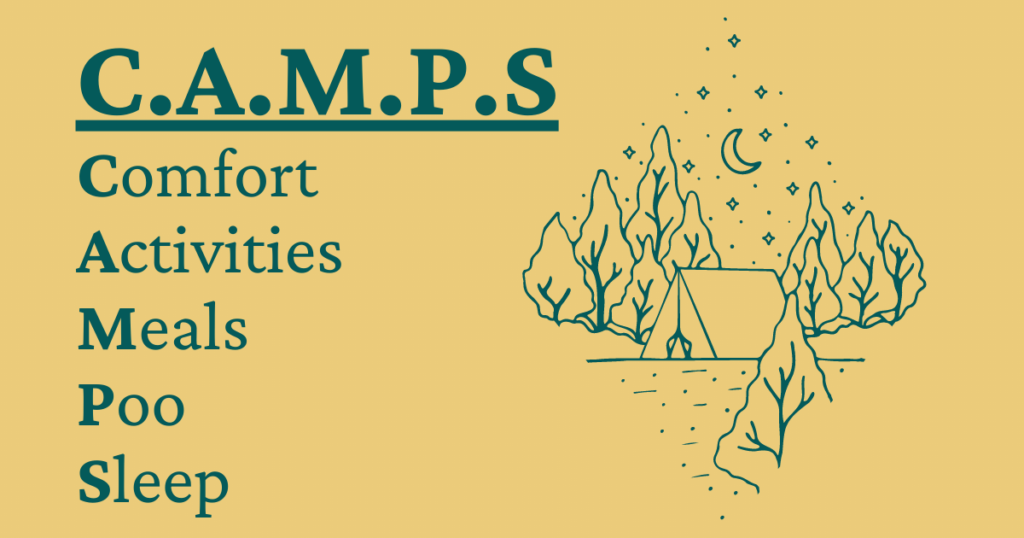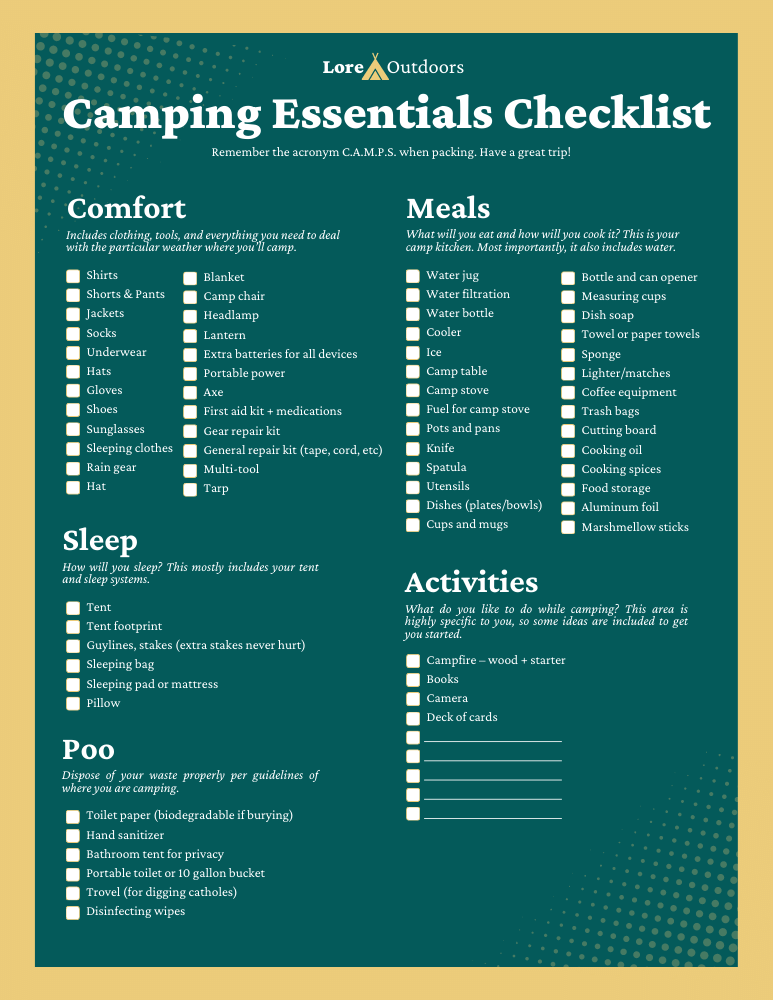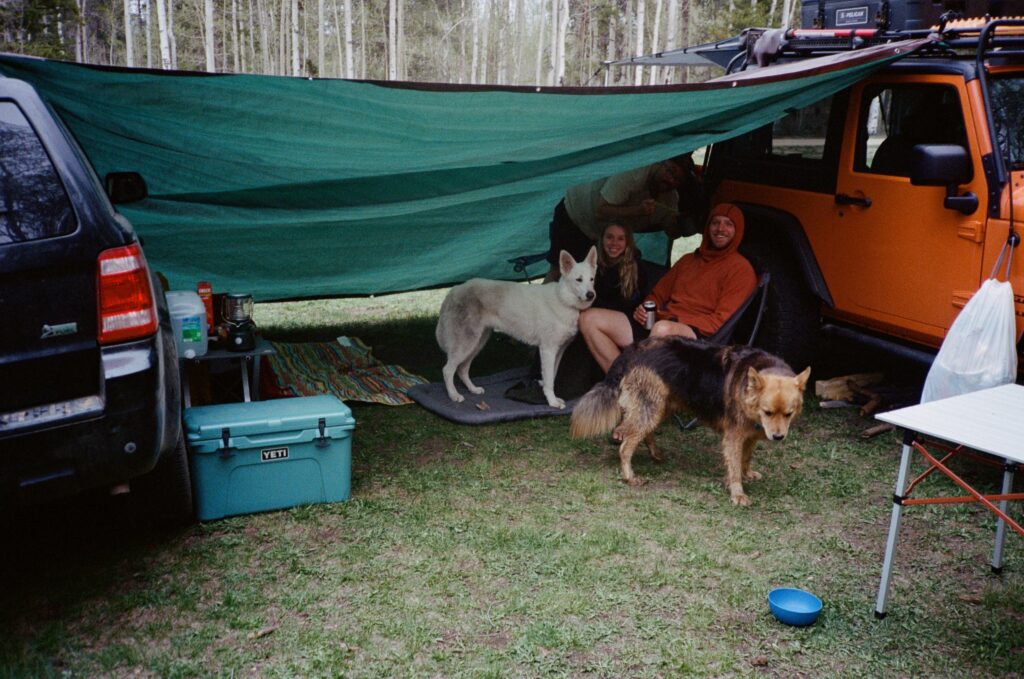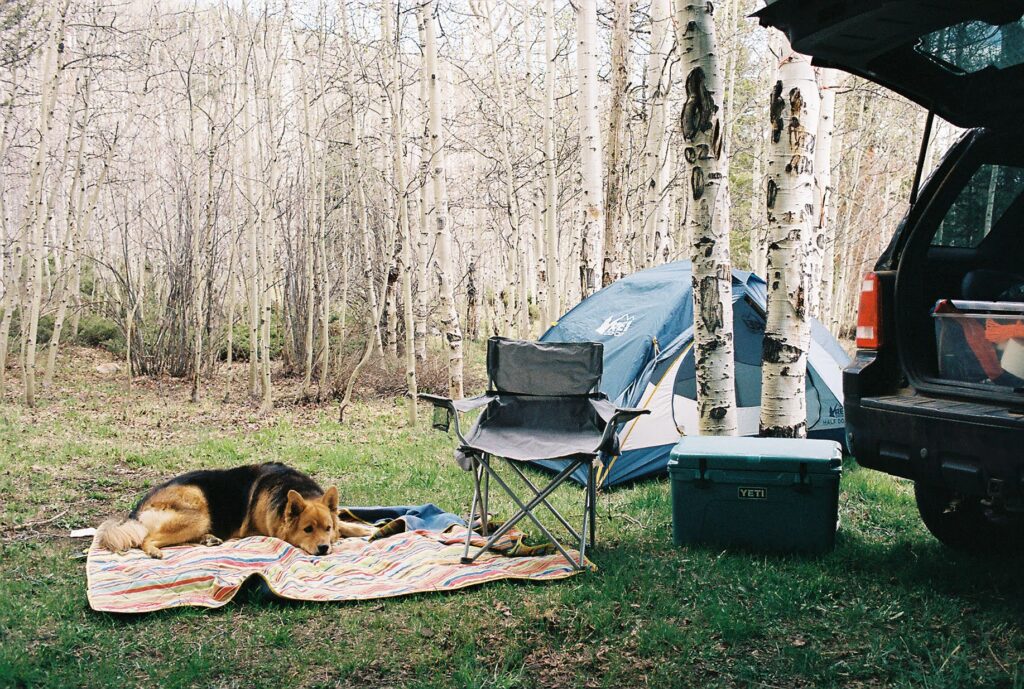I wouldn’t recommend cooking out of a coffee kettle. But during a camping trip in the mountains outside Leadville, Colorado that’s exactly what I did. While unpacking for dinner I realized I’d left all my pans at home, leaving me no choice but to cook where I steep. Even though I can look back and laugh now, the experience lead me to document all my camping essentials from top to bottom to make sure it didn’t happen again. I prefer my morning coffee to taste like coffee and not last nights veggies and sausage.
As I put together that list I realized there’s a lot more than just gear that goes into a camping trip. There are many aspects of planning I take for granted when I prep for a weekend away. So I wrote it all down, and today I’ll share more than 20 years of camping experience to help you have a successful trip.
In this guide we’ll cover:
- C.A.M.P.S. – The 5 groups of must-have camping gear
- Camping essentials list – An interactive and printable guide you can use for any trip
- Camping info to know before you go
- Gear – Creating your camping kit
- What most people forget to bring (and how not to!)
- Resources for finding a place to camp
- Camping essentials for women
- Camping with your dog
One reminder before we dive in: this guide is focused on car camping in campgrounds, but I’ll note specific changes for dispersed camping and backpacking throughout to show you how things change for different types of camping. Let’s get to it!
C.A.M.P.S. – 5 groups of must-have camping gear

An easy way to remember everything you need is with the acronym C.A.M.P.S. This is how I run through what gear I need for every camping trip whether I’m backpacking, car camping, or dispersed camping. It’s an easy mental check to make sure you aren’t forgetting anything vital. The gear we walk through in this post will be organized by C.A.M.P.S. to show you how it works in reality.
Comfort—Includes clothing, tools, and everything you need to deal with the particular weather during your trip.
Activities—What do you like to do while camping? I like hiking, reading, and photography so I always have a list of those particular items to bring. Maybe you like music or fly fishing or card games. This area is highly specific to you.
Meals—What will you eat and how will you cook it? This includes both camp kitchen supplies and cooking ingredients. Most importantly, it also includes water.
Poo—Everybody hurts poos. Depending on where you’re camping your needs for going to the bathroom and general hygiene will vary. But don’t worry, this doesn’t need to be stressful and we’ll walk through what you need no matter the situation.
Sleep—This includes your tent and sleep systems, the core of your campsite.
When I think through CAMPS I am asking myself questions for each area while I check through my gear. How and what will I eat? How will I sleep? How will I go to the bathroom? What are we doing this trip? It makes everything easier to think through. Add in a checklist and you’re sure to be the one in your group letting your friends borrow gear instead of the other way around.
The camping essentials list

Use our printer-friendly checklist as a shopping list or packing list for your next camping trip.
Grab our checklist and use it as a template to customize your own packing list over time. Camping is personal, so this should act as your starting point not the final word.
I personally use this checklist in an Apple Note when I pack for every trip. Some people like physical paper, but I find this to be easy and simple since I can use the checklist feature and mark gear off as I go. For your convenience, I’ve got three ways you can use our checklist here. Download the PDF above, use the interactive checklist below and bookmark this page for use later, or you can copy and paste the interactive checklist into an Apple Note for yourself using this Google Doc. Use what works best for you!
Comfort
Includes clothing, tools, and everything you need to deal with the particular weather during your trip.
Clothing
Equipment
Hygiene & More
Activities
What do you like to do while camping? I like hiking, reading, and photography so I always have a list of those particular items to bring. Maybe you like music or fly fishing or card games. This area is highly specific to you, so some ideas are included to get you started.
Meals
What will you eat and how will you cook it? This includes both camp kitchen supplies and the ingredients itself. Most importantly, it also includes water.
Poo
Depending on where you’re camping your needs for going to the bathroom and general hygiene will vary drastically. If in a campground with toilets you may just want extra toilet paper and hand sanitizer. If you’re dispersed camping with no toilets available you need to have a plan for your poo. Either pack it out or bury it using LNT principles (6 inches) – check regulations where you’re camping as some places don’t allow burial.
Sleep
How will you sleep? This mostly includes your tent and sleep systems.
Camping info to know before you go

Before we start packing there is some key information you should have decided.
- Campsite—Where are you camping? Do you need a permit, or a reservation? Check the bottom of this post for resources on how to find a good campsite.
- Money and ID—Cash is king at many campgrounds. Have cash, card, and your ID on you just in case.
- Backup plan—What will you do if bad weather hits? If you’re dispersed camping, where will you go if spots are taken?
- Leave No Trace principles. Know them and use them.
- Campfire regulations—Are you allowed to have campfires where you’re going? What are the rules around firewood? Often you’re not supposed to bring firewood with you from home due to insects and diseases that can spread.
Gear: Creating your camping kit
When looking at gear try to think about what your overall outdoor needs and hopes are. Since I enjoy backpacking just as much as car camping, I buy backpacking gear and use it for both. I would rather have one item I can use instead of two versions. This doesn’t work for everything, cooking equipment for example, but when I can I use one piece of gear across all types of camping.
To start, I’d recommend making sure you feel good about your sleeping and cooking systems first, everything else you’re more likely to have a version of at home. The essentials list below has some recommendations, look at them with this in mind: Get outside first with what you have, then upgrade what matters. For example, I upgraded my tent, sleeping bag, and coffee setup because those items get used a lot and make camping a better experience for me. But my trusty cast iron pan gets used at home and out camping, because why have two? Over time you’ll learn what gear matters to you and what you should spend on.
Camping supplies most people forget (and how not to!)
My coffee kettle cooking experience told above shows what happens when you forget gear. While I like using some items for both home and camping, this might be a good argument against that. Let’s talk a bit more about common gear campers forget and the two main ways to never forget anything again.
The most commonly forgotten items are the small accessories or items you use both at home and while camping. Forgetting an item can create hilarity, but also stress you don’t need during your escape from city life. Here are a few items I’ve forgotten on trips in the past to make sure to have in your kit:
- Extra batteries for battery powered devices
- Fuel for camping stoves.
- Lighter or matches (campfire or your camp stove)
- Headlamp
- Cooking oil, pans, spatula, and spices.
There are two main ways to reduce forgetfulness. First, is use your camping essentials checklist when packing. The second is a piece of gear I recommend to be at the very top of your list, which is a camping storage box. A camping box is a beautiful piece of gear, serving as tote, cutting board, chair, weight, and more. It’s the quiet, reliable foundation on which your kit is built. All the small items you’ll use when you go camping should go in here and stay in here. You should look for a box with a minimum 14 gallon capacity. Any smaller and you’ll struggle to fit your bigger items in like your kettle alongside everything else.
I recommend the Rubbermaid Actionpacker due to its size and durability. You’ll use this box for years. Growing up, we used Rubbermaid Roughneck Storage Totes (18 gallon) from the garage. These work great too, and lasted many years before they would split or break handles from weight and rough use. It’s difficult to find a single Roughneck tote for sale online, but head to any home improvement store and you should be able to find them or a similar product.
Find a place to camp with these resources
There are a multitude of options when it comes to car camping from national parks, to BLM land, to private campgrounds. Below is a list of resources I’ve used to find campsites in the past. Many are focused on a specific type of camping, but its worth spending some time with multiple of them to find your favorite or which one works best for your region.
- Recreation.gov—Focused on government-owned areas and national parks, recreation.gov is the place for permits and campsites at some of the best places the United States has to offer.
- Campendium—A great resource for finding different types of campsites from RV parks to free dispersed sites and everything in between.
- Stateparks.com—An amazing resource for seeing what state parks your state has, which offer camping, and even finding a reservation all in one place. I love this site.
- State DNR or Parks & Wildlife websites—If you want to discover the options in your particular state these sites can be very helpful to explore. They’ll guide you to whatever booking options they have as well. Here’s Colorado’s as an example.
- Reserve America—Many state agencies use ReserveAmerica for their camping reservations, so you’ll end up here using some of the sites above. But other government-related sites and privately owned properties are available on Reserve America too.
- Go Camping America–Focused on privately owned campgrounds around the United States.
- The Dyrt—Another campsite reservation and discovery site, you’ll find a mixture of government land and free campsite listings here.
- iOverlander—Built for all types of overlanding resources, iOverlander is a favorite of those who live on the road full time. Great if you’re planning a big road trip.
- USFS & BLM Campgrounds App—If dispersed camping is your thing this app is a great library of available campsites and descriptions across the United States. The app costs $0.99 to download.
- Freecampsites.net—Focused on dispersed camping, this site can be hit and miss. Make sure to check the reviews of sites if possible.
- KOA.com—KOA’s are common all over the country offering RV sites, cabins, and tent sites with amenities.
Camping essentials for women
While some items specifically for ladies are included in the checklist above, it’s worth sharing a dedicated list of items for women here. Everything on this list is recommended by the experienced mountain guides and outdoorswomen who I’ve adventured with for years. Their setups are dialed in and built from experience. Thanks to their packability, these items are all great for backpacking just as much as car camping too.
- Kula cloth or bandana
- Tampons
- Pads
- Hair ties
- Sports bras
- Wet wipes
- Ibuprofen/Acetaminophen (if not already in your med kit)
- Extra plastic bag for trash (best if opaque)
- Smooth move tea bags and/or ginger tea. These can be helpful for stomach issues and period discomfort.
Camping essentials for your dog

I wouldn’t dare go on a camping trip without my pup Scout. We’re at our best exploring the mountains and outdoors together, but there are always considerations to make when bringing your pup along. First, make sure where you’re camping allows dogs and know the regulations for the larger land you’ll be camping on. National forest and BLM land is typically more relaxed, but if you’re in wilderness areas or set campgrounds there will likely be leash laws. Once you’re set on that, packing is actually easy. I apply the same CAMPS system to Scout to make sure I never forget anything. I’ve also included a special dog section in the checklist you can download.
- Comfort—Is your dog built for cold or warm weather? Scout has thick fur so usually this section considers keeping him cool on hot summer days. That means extra water and shade, but it could mean a jacket and extra blankets for you.
- Activities—For the activities you listed above, what does your pup need? I like to have Musher’s Secret on hand to protect paws for hiking, as well as a light-up collar, collapsible water bowl, and even booties for hiking.
- Meals—Dog food and treats of course, but also consider any medications or special needs. Scout has hypothyroid so I always make sure to have his daily medication with me.
- Poo—Always have a plan for, and properly dispose of, your dogs poo. Read why this is important here. Just like human waste, dog’s poo doesn’t break down the same way as other animals. Please be respectful.
- Sleep—Will the nights be warm or cool? This could be a dog bed and blankets all the way up to specialized dog sleeping bags. I have a few extra blankets I use alongside giving Scout my jackets at night, and I have a packable down blanket I bring for cold nights both camping and backpacking.
Onwards and outwards
Camping is the best way to unplug from daily life and reset. I hope this guide makes it easier for you to take your next camping trip and make it a successful one.
If you used this guide to go camping, please email us at [email protected], we’d love to hear all about it. If you think something is missing from our checklist or this guide email [email protected].
Alex Eaton
I'm Alex, the founder of Lore. My life outside started with camping trips in southern Indiana as a kid, and has taken me across the world. My goal is to give you the tools and confidence you need to pursue the outdoor life you want.
Use our printer-friendly checklist as a shopping list or packing list for your next camping trip.